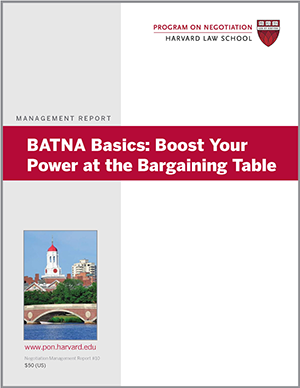
What is your greatest source of power in negotiation? In their landmark negotiation book Getting to Yes: Negotiating Agreement Without Giving In (Penguin, 1991), Roger Fisher, William Ury, and Bruce Patton write that it is often a strong BATNA, or best alternative to a negotiated agreement. Before and during their negotiations, wise negotiators determine their back-up plan and try to improve it: Job hunters follow other job leads, buyers talk to suppliers’ competitors, and so on.
Your BATNA can be a useful measure of a deal’s quality and a source of power, giving you a sense of whether to accept the deal or push for more. But while it’s hard to overstate the importance of BATNA in negotiation, an overly narrow focus on our BATNA can lead us to leave significant value on the table.
BATNA and Long-term Relationships
Because the BATNA concept is often defined as an “outside option,” independent of one’s current negotiation, it can be difficult to apply to negotiations with thriving partnerships, writes Harvard Business School professor James Sebenius in an article in Negotiation Journal.
“Think of a reasonably content married couple or successful business partners negotiating an issue of keen mutual interest on which they have different preferences,” writes Sebenius. If that married couple can’t agree on where to live after retirement, the only obvious “outside option” would be separation or divorce—hardly an appealing BATNA if they are “reasonably content.” Similarly, if partners in a successful business can’t see eye to eye on a critical issue, they are unlikely to view the dissolution of their partnership as an acceptable BATNA.
Rather than thinking of our best alternative to a negotiated agreement as an “outside option,” Sebenius advises us to think of it more broadly as a “no-deal option.” When framed this way, exercising our BATNA doesn’t require us to walk away from our negotiating partner if we’re unsatisfied with their proposal; it just requires us to keep saying no.
Specifically, Sebenius recommends considering the full consequences of saying no and how we might influence those consequences to our advantage. Such consequences might include “costs or risks borne by each side, foregone benefits, altered settlement possibilities, damage to the relationship,” and so on, he writes.
Putting on the Pressure
At Amazon’s warehouses in the Minneapolis area, many workers are East African refugees who have struggled to meet increasingly challenging quotas for packing boxes for delivery to customers. Some Muslim employees said they were given breaks to pray but feared they would fall behind and be fired if they took them. Others complained they didn’t get medical attention when they suffered health crises at work.
With the help of the Awood Center, a local nonprofit that assists East Africans, some of the employees banded together to protest for better working conditions, reports Karen Weise in the New York Times. Managers agreed to certain changes, such as assigning a manager to quickly respond to individual workers’ complaints, but many workers viewed these concessions as insufficient and continued to stage walkouts.
“Nobody would assume a Muslim worker, with limited language skills, in the middle of Minnesota can be a leader in a viable fight against one of the biggest employers in the world and bring them to the table,” Awood executive director Abdirahman Muse told the Times.
Why have the Amazon employees made headway? They looked beyond their individual BATNAs to Amazon’s BATNA—and how they might worsen it by banding together, in part through collaborative leadership. The workers recognized that “Amazon would have a very difficult time replacing” them, University of Illinois at Chicago employment researcher Beth Gutelius told the Times. By banding together, the workers made it difficult for Amazon to fire them and motivated the retailer to offer concessions.
BATNAs and Beyond
The following negotiation techniques and tactics will help you look beyond negotiation basics and reach better agreements:
- View your BATNA as a no-deal option rather than an outside alternative. Don’t assume you have to threaten to walk away from a relationship to get what you want. As you reject the offer on the table, look for ways to put pressure on the other party.
- Work to enhance the deal on the table. Negotiators often pass up opportunities to create value. Avoid this mistake by probing your counterpart’s interests and exploring how you might meet them.
- Increase their dependence on you. Research your counterpart’s likely BATNA, then explore ways to deepen their dependence on you.
How have you used the best alternative to a negotiated agreement concept to get more out of your negotiations?





